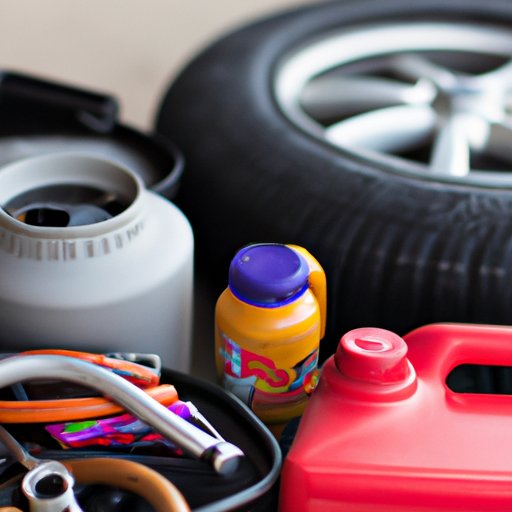Introduction
Going on a road trip can be an exciting experience. But before you hit the open road, it’s important to make sure your vehicle is in good shape. Properly preparing your car for a road trip will ensure your safety and help you avoid unnecessary delays and costly repairs. In this article, we’ll discuss the importance of preparing your car for a road trip and provide step-by-step instructions for tasks such as checking tire pressure, performing an oil change, topping off all fluids, testing the battery and alternator, and packing an emergency kit.

Check the Tire Pressure and Tread Depth
It’s important to check the tire pressure and tread depth before embarking on a road trip. According to the National Highway Traffic Safety Administration (NHTSA), underinflated tires “reduce fuel economy and increase the risk of tire failure from overheating.”
To check the tire pressure, you’ll need a tire pressure gauge. You should also have a tire pressure chart handy so you know what the correct pressure should be for your vehicle’s tires. To check the tread depth, you’ll need a tire tread depth gauge. It’s important to make sure the tread isn’t too worn out, as this can affect the vehicle’s handling and braking ability.
To maintain proper tire pressure and tread depth, it’s important to regularly inspect your tires and have them rotated every 5,000 miles or so. Additionally, make sure to keep an eye out for any signs of wear and tear, such as bulging or cracking.
Perform an Oil Change
Having clean, fresh oil in your engine is essential for keeping your vehicle running smoothly. The oil helps to lubricate the engine and remove contaminants and debris. That’s why it’s important to perform an oil change before a road trip. According to the American Automobile Association (AAA), “regular oil changes are the key to extending the life of an engine.”
When performing an oil change, it’s important to use the right type of oil for your vehicle. Consult your owner’s manual for the recommended type of oil for your vehicle. You’ll also need a few basic tools, such as an oil filter wrench, an oil drain pan, and some rags.
To perform an oil change, first warm up your engine for a few minutes. Then, place the oil drain pan underneath the oil plug and remove the plug. Allow the old oil to drain completely. Next, replace the oil filter and reinstall the oil plug. Finally, pour in the new oil and dispose of the used oil properly.
Top Off All Fluids
Topping off all of the fluids in your vehicle is another important step when preparing your car for a road trip. This includes checking the levels of coolant, brake fluid, power steering fluid, and windshield wiper fluid. If any of these fluids are low, top them off with the appropriate type of fluid.
Topping off all of the fluids in your vehicle has several benefits. It helps to maintain the performance and efficiency of the vehicle, and it can reduce the likelihood of a breakdown while on the road. Additionally, it can extend the life of your vehicle’s components.
To top off all of the fluids, first locate the reservoirs for each fluid. Then, check the levels and top off any that are low. Make sure to use the correct type of fluid for each reservoir. Refer to your owner’s manual or the manufacturer’s website for more information.
Test the Battery and Alternator
Testing the battery and alternator is another important step in preparing your car for a road trip. A weak battery or faulty alternator can leave you stranded in the middle of nowhere. That’s why it’s important to make sure both are in good working order before you hit the road.
To test the battery and alternator, you’ll need a voltmeter, which is a device that measures voltage. To test the battery, start by turning off the engine. Then, attach the voltmeter to the battery terminals and check the voltage reading. If the reading is below 12 volts, the battery likely needs to be replaced. To test the alternator, start the engine and attach the voltmeter to the alternator terminals. The voltage reading should be between 13.5 and 14.5 volts.
If the battery or alternator fails the tests, it’s best to have them replaced before going on a road trip. This will help to ensure your vehicle runs reliably during the trip.
Pack an Emergency Kit
Finally, it’s important to pack an emergency kit when preparing your car for a road trip. This kit should include essential items such as a first aid kit, flashlight, flares, jumper cables, and a tool kit. It’s also a good idea to bring along some snacks, water, and a blanket in case of an emergency.
Having an emergency kit can come in handy if your car breaks down or you get stuck in bad weather. It can also be useful if you’re stranded somewhere and need to wait for help. Having an emergency kit with you can give you peace of mind while on the road.
Conclusion
Taking the time to properly prepare your car for a road trip can save you a lot of stress and money in the long run. From checking the tire pressure and tread depth to performing an oil change, topping off all fluids, testing the battery and alternator, and packing an emergency kit, there are many steps you can take to ensure your vehicle is ready for the journey ahead. By following these tips, you can enjoy a safe and enjoyable road trip.
(Note: Is this article not meeting your expectations? Do you have knowledge or insights to share? Unlock new opportunities and expand your reach by joining our authors team. Click Registration to join us and share your expertise with our readers.)
